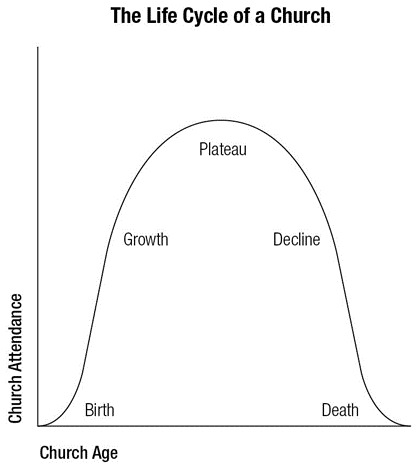The Explanation
The information above indicates that the North American church is not on a plateau but in decline. It is facing a major growth challenge. It is over the life-cycle hump and moving downward. Before venturing to offer a solution to the problem, I want to look at an explanation for the problem. I believe an understanding of the reason the problem exists is a major step toward solving it. As someone once said, a problem well defined is a problem half solved.

Experts have put forth numerous explanations for why the North American church is struggling. Many lay blame. Based on the information above, you could blame the church for not doing a better job of evangelism and edification. If 65 percent of the people in the churches are either plateaued or declining in their spiritual growth, it is no wonder that so many churches are struggling.
You might also blame the seminaries and colleges that train the church’s leaders. A scan of the typical seminary curriculum would reveal that far too many are not aware of what is taking place in North American culture and its impact on the typical church. Though many seminaries and Christian colleges have begun to use the new technology, they are typically business as usual when it comes to the curriculum.
My view is that the problem is not what evangelical seminaries teach but what they do not teach. Many evangelical seminaries teach the Bible and theology, and it is imperative that they do so. However, they often do not provide strong training in leadership, people skills, and strategic thinking skills, and this is poor preparation for ministry in today’s shrinking world, which is undergoing intense, convoluted change.
The Sigmoid Curve
It is easy to lay blame, and many need to wake up or pull their heads out of the sand. However, a bigger, more fundamental explanation of the problem is represented by the sigmoid curve. We can better understand much of what is taking place in North American Christianity in general and churches in particular if we understand the concept of the sigmoid curve.
The term sigmoid simply means “S-shaped.” The S-shaped curve represents the natural development of one’s personal life and relationships. It also represents the natural development of biological systems, institutions, worldviews, civilizations, and organizations including the church.
The S-curve depicts how virtually everything in life begins, grows, plateaus, and then ultimately dies. It is true of human beings. It also may be true of relationships such as marriage. It is true of one’s leadership and it is true of civilizations, as proved by the Greek and Roman empires in the past and the Russian empire today. The Fortune 500 companies demonstrate that it is true of businesses, as a number of companies who made the list one, two, or more years ago are not on that list today. In physics it is the second law of thermodynamics. In biology it is extinction. In terms of worldview it is the shift from theism to deism and then to naturalism or modernism. And today it is the shift from modernism to postmodernism. Not even the church is an exception to the pattern. In short, the world and everything in it are all somewhere on the S-curve.
As it relates to the church, the S-curve represents essentially its life-cycle pattern. Like people, churches have a life cycle. In general, a church is born and over time it grows. Eventually it reaches a plateau, and if nothing is done to move it off that plateau, it begins to decline. If nothing interrupts the decline, it will die. Each stage represents a growth challenge for the church. Growing, plateaued, and declining churches all face growth challenges. Some are alike, but most are unique to the church’s particular situation and where it is on the S-curve.
The Message
The message or lesson of the sigmoid curve is that all good things (and even some bad things) end. In a world of constant, turbulent change, many relationships and most organizations do not last. The pattern is that they wax and eventually wane. Even brand-new institutions and organizations such as a church will, in time, plateau and then die. No matter what institution it is, organizational “dry rot” sets in. The institution becomes brittle, ceases to function, and expires.

This concept has been true since the fall of mankind as recorded in Genesis 3. The bad news for the twenty-first century is that today decline is happening faster than ever before. In the first three-quarters of the twentieth century, for example, decline was a relatively slow process. It took time for things to change and eventually die. You had some advance warning and time to address the changes. However, writing in 1994, Charles Handy warns, “Those units of time are also getting depressingly small. They used to be decades, perhaps even generations. Now they are years, sometimes months. The accelerating pace of change shrinks every sigmoid curve.” I would add that it has shrunk not only to years and months but in some cases also to days.
While it does prove helpful to examine specific reasons for the decline of churches, the lesson is that it will happen anyway. We can learn from this information and try to discover what to do as well as what not to do. Regardless, in time the end is inevitable. This was true of the spiritually strong and not so strong churches of the first century. Those ministries live on today in the churches of the twenty-first century. However, the original churches are no longer. If you travel to the Middle East, you will not find any of them.